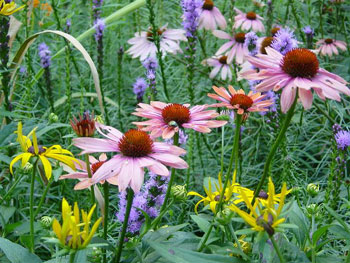After such a long, hard winter, spring is especially welcome this year. The birds are singing and wonder returns as a diversity of plants emerge from the ground as if by magic.
This year, there’s a push among private landowners – farmers and ranchers – to help beleaguered birds, bees, monarch butterflies and other pollinators. As agriculture has spread over our most productive lands, it has wiped out native plants, grasslands and wetlands that so many species rely on, and now there’s an effort to bring some of that back.
The Department of Agriculture is working with farmers and ranchers, encouraging them to use more sustainable practices: grow plants that both pollinators and cows like, such as alfalfa and clover; and manage grazing rotations better to let plants replenish the land. Grow native plants and wildflowers which besides providing nectar, reduce the need for pesticides because they support beneficial insects that eat pests.
Some of my garden nectar plants – coneflower (Echinacea) and black-eyed susan (Rudbeckia):

These practices have spread across 43 million acres, thanks to $630 million from the 2008 Farm Bill, which directed the Natural Resources Conservation Service to foster the health of pollinators across the US.
"When I talk about hedgerows to guys in Iowa, they just kind of glaze over," because big bushes interfere with the giant equipment farmers use, Laurie Adams, executive director of the Pollinator Partnership, told the NY Times. They would rather set aside separate areas for pollen-rich plants to accomplish conservation goals. "This is not one size fits all, this is one ethic fits all."
Helping Birds During Migration
Another program, BirdReturns, is an example of "Precision Conservation," that provides "pop-up" resources where birds need them.
During migration, for example, birds need to stop for water along routes that span hundreds of miles.
"First we pinpoint where and when birds will need to land using data from millions of citizens at eBird, next we find out if there will be available water using predictive satellite maps, and then we pay farmers a competitive price to flood their fields at the exact time when the most birds will need to land," explains The Nature Conversancy. The price is based on farmers’ bids in an auction.
A rice farmer, for example, would keep their fields flooded as migrating flocks of birds arrive. Since the program only lasts a few weeks in the spring and fall, the cost is modest.
Even during California’s severe drought this year, 40 rice farmers managed to keep about 250 acres each flooded during migration – about 10,000 of the 500,000 acres farmed for rise in the Central Valley.
Researchers immediately got results – numbers rose for birds of concern. It is often during migration – the hardest part of a birds’ life – that the population plummets because they can’t find stopover places to rest, eat and drink.
Dangers to Pollinators Continue
While most of the attention on declining bee populations has been on honey bees (native to Europe and shipped around the US to pollinate crops) – wild bees native to the US are much better pollinators, according to research by The Nature Conservancy. Organic farms with diverse crops attract wild bees.
The use of neonicotinoid pesticides is under fire as a leading cause of colony collapse, but research shows they are responsible for plummeting populations of all kinds of wildlife, such as fish, amphibians, birds and bats. The pesticides – which persist in the soil, accumulating and leaching into waterways – suppress their immune system making them more vulnerable to infectious diseases. Chemicals residues are at high enough concentrations to be lethal for pollinators.
"We are already seeing a shift in behavior among apple growers in New York state. Fewer and fewer are renting honeybee colonies for pollination and more are willing to adopt practices that promote native bee abundance and diversity because when the native bees are abundant, they no longer need to bring in honeybees. Farmers who adopt pollinator conservation strategies may find that this is a more cost-effective method for achieving pollination than renting honeybee colonies," says Bryan Danforth, Professor of Entomology at Cornell University.
That’s good, because researchers are increasingly concerned that honey bee diseases can be transmitted to wild bees. Environmental groups have petitioned the USDA for four years to regulate the movement of commercial bees, prohibiting them from crossing state lines unless they are proven to be disease-free. The USDA has yet to respond, even as several species are in serious decline.
You have to wonder why farmers have been paying each year to truck non-native bees around to pollinate their crops, when all they need to do is provide the food our native bees need to thrive.
We’ve gone so astray in our society, even moving to "industrialize" nature. It doesn’t work and is more expensive.
If you’d like to help, consider becoming a citizen scientist – report bird sitings on eBird and bees at Bumble Bee Watch. You’ll be helping to create a comprehensive map that shows where they are thriving and where they need help.
And of course, plant native wildflowers at home. Purchase organic seeds or plants from native nurseries to make sure they aren’t treated with these pesticides – as they are at Home Depot and Lowe’s!
Find out which plants pollinators prefer where you live:
